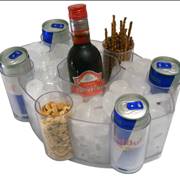

While working for German manufacturer Blendax (later acquired by Procter & Gamble) in 1982, Dietrich Mateschitz travelled to Thailand and met Chaleo, owner of T.C.

#12 OZ RED BULL CAFFEINE CONTENT YELLOW DRIVERS#
It was popular among Thai truck drivers and labourers. In 1976, Chaleo Yoovidhya introduced a drink called Krating Daeng in Thailand, which means "red gaur" in English. History In front of the Potala Palace, Tibet: a large can of the Chinese version of Red Bull. Both Red Bull and Kraeting Daeng use the same red bull on yellow sun logo while continuing to market their drinks separately in the Thai and Western markets. In 1996, Red Bull began operation in the United States, and has seen steady growth ever since. In 1987, the company sold its first can of Red Bull in Austria. When branding their new product, Mateschitz referenced Krating Daeng's name: in Thai, daeng means red, and a krating (known in English as a gaur or Indian bison) is a large species of wild bovine native to the Indian subcontinent. In 1984, the two founded Red Bull GmbH in Fuschl am See, Salzburg, Austria. Mateschitz sought to create a partnership with Yoovidhya and formulated a product that would suit the tastes of Westerners, such as by carbonating the drink. While doing business in Thailand, Dietrich Mateschitz purchased a can of Krating Daeng and claimed it cured his jet lag. Red Bull was first derived from a similar drink called Krating Daeng which originated in Thailand and was introduced by the pharmacist Chaleo Yoovidhya. In addition to sport series, its marketing includes multiple sports team ownerships celebrity endorsements and music, through its Red Bull Records label.
#12 OZ RED BULL CAFFEINE CONTENT YELLOW SERIES#
Rather than following a traditional marketing approach, Red Bull has generated awareness and created a "brand myth" through proprietary extreme sport event series such as Red Bull Cliff Diving World Series, Red Bull Air Race, Red Bull Crashed Ice and standout stunts such as the Stratos space diving project. Its slogan, "Red Bull Gives You Wings", is considered one of the most popular and memorable advertising slogans in the United States, ranking at 16 out of 25 with a 59.3% slogan recognition rate according to a study by advertising and market research firm Survata. Originally available only in a single nondescript flavor sold in a tall and slim silver-blue can, called Red Bull Energy Drink, numerous variants of the drink were added over the course of time. Sinсe its launch in 1987, more than 100 billion cans of Red Bull have been sold worldwide, including over 11.5 billion in 2022. With a market share of 43%, it is the most popular energy drink brand as of 2020, and the third most valuable soft drink brand behind Coca-Cola and Pepsi. Red Bull is a brand of energy drinks created and owned by the Austrian company Red Bull GmbH. Caffeine, taurine, glucuronolactone, sucrose and glucose, B-group vitamins, and water


 0 kommentar(er)
0 kommentar(er)
